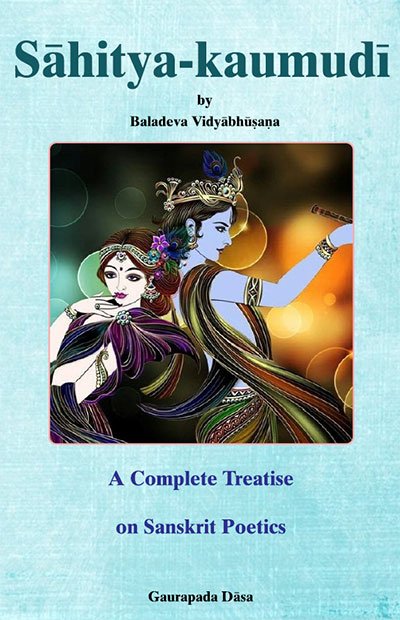Sahitya-kaumudi by Baladeva Vidyabhushana
by Gaurapada Dāsa | 2015 | 234,703 words
Baladeva Vidyabhusana’s Sahitya-kaumudi covers all aspects of poetical theory except the topic of dramaturgy. All the definitions of poetical concepts are taken from Mammata’s Kavya-prakasha, the most authoritative work on Sanskrit poetical rhetoric. Baladeva Vidyabhushana added the eleventh chapter, where he expounds additional ornaments from Visv...
Text 2.20
अगूढं यथा,
agūḍhaṃ yathā,
This verse illustrates an unsubtle implied sense:
gopyas tapaḥ kim acaran yad amuṣya rūpaṃ lāvaṇya-sāram asamordhvam ananya-siddham |
dṛgbhiḥ pibanty anusavābhinavaṃ durāpam ekānta-dhāma yaśasaḥ śriya aiśvarasya ||
What austerities did the gopīs do? With their eyes they drink His form, the essence of loveliness! His form is unequalled and unsurpassed, not perfected by anything else, youthful at every moment, difficult to attain, and the foremost repository of fame, beauty and power. (Bhāgavatam 10.44.14)
atra dṛgbhiḥ pānasyāsambhavāt sādarāvaloko lakṣyate. gāḍhāsaktir vyaṅgyā, sā ca vācyavat-pratīter agūḍhā.
In this verse, a highly-respectful glance is indicated because of the impossibility of drinking with the eyes. A deep loving attachment is implied, and it is not subtle since it is perceived as if it were a literal meaning.
Commentary:
Viśvanātha Cakravartī Ṭhākura explains the verse in this way: tāsāṃ dṛgbhiḥ pānasyaiva tādṛśa-tapaḥ-phalam uktvā svāṅgair āliṅganādes tv anirvācya-hetukatvaṃ jñāpitam, “By stating the result, derived from the austerities, of drinking with their eyes, what is subtly made to be known is that the cause of their embracing Him with their limbs is inexpressible” (Sārārtha-darśinī 10.44.14). That constitutes an implied arthāpatti ornament (presumption) (11.35). In other words: “If we cannot explain how the gopīs became fortunate enough to constantly see Him, what can we possibly say about the reason they constantly meet Him!”
